Intro
Discover the causes, symptoms, and treatment of Periodic Limb Movement Disorder, a sleep disorder characterized by involuntary leg movements, restless leg syndrome, and sleep disruptions, affecting overall sleep quality and daytime functioning.
Periodic limb movement disorder, also known as PLMD, is a condition that affects millions of people worldwide. It is characterized by involuntary movements of the legs and arms, typically occurring during sleep. These movements can range from mild to severe and can disrupt sleep patterns, leading to fatigue, daytime sleepiness, and other related issues. Understanding periodic limb movement disorder is crucial for developing effective treatment strategies and improving the quality of life for those affected.
The importance of addressing periodic limb movement disorder cannot be overstated. Not only does it impact the individual's sleep quality, but it can also have significant effects on their overall health and wellbeing. For instance, chronic sleep deprivation can lead to decreased cognitive function, increased risk of accidents, and a weakened immune system. Furthermore, PLMD can also have a significant impact on relationships, work performance, and daily activities. Therefore, it is essential to delve into the world of periodic limb movement disorder, exploring its causes, symptoms, diagnosis, and treatment options.
Periodic limb movement disorder is a complex condition, and its underlying causes are not yet fully understood. However, research suggests that it may be related to imbalances in brain chemistry, particularly dopamine and serotonin levels. Other potential contributing factors include genetics, iron deficiency, and certain medications. Additionally, PLMD can be associated with other sleep disorders, such as restless legs syndrome, sleep apnea, and insomnia. As research continues to uncover the mysteries of PLMD, it is clear that a comprehensive approach is necessary to address this condition effectively.
What is Periodic Limb Movement Disorder?
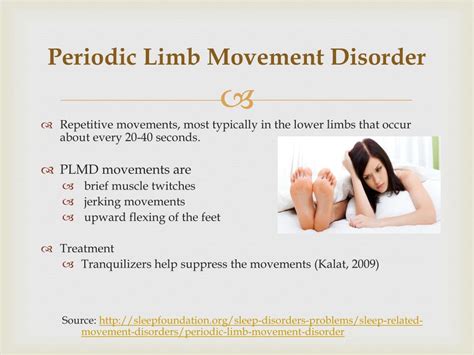
Symptoms of Periodic Limb Movement Disorder
The symptoms of periodic limb movement disorder can vary from person to person, but common symptoms include: * Involuntary movements of the legs and arms during sleep * Restless sleep * Daytime fatigue and sleepiness * Difficulty concentrating and decreased cognitive function * Mood disturbances, such as irritability and anxiety * Sleep disruptions, such as insomnia and sleep apnea * Vivid dreams and sleep talkingCauses and Risk Factors of Periodic Limb Movement Disorder
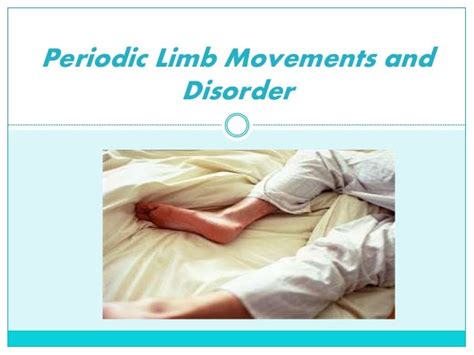
Diagnosis of Periodic Limb Movement Disorder
Diagnosing periodic limb movement disorder can be challenging, as the symptoms can be similar to those of other sleep disorders. A comprehensive diagnosis typically involves: * Medical history: A thorough review of the individual's medical history, including any underlying medical conditions and medications * Physical examination: A physical examination to rule out any underlying medical conditions that may be contributing to the symptoms * Sleep study: A sleep study, such as a polysomnogram, to monitor the individual's sleep patterns and detect any abnormal movements * Questionnaires: Standardized questionnaires, such as the International Restless Legs Syndrome Study Group rating scale, to assess the severity of the symptomsTreatment Options for Periodic Limb Movement Disorder
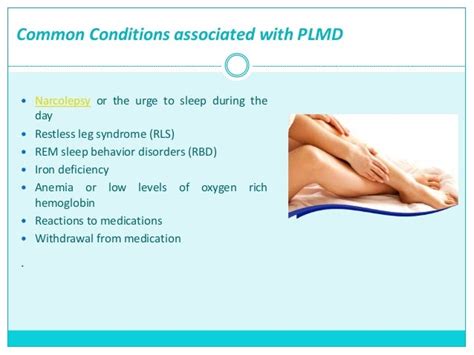
Behavioral therapies, such as cognitive-behavioral therapy, can help individuals with PLMD develop coping strategies and address any underlying psychological issues. Medications, such as dopamine agonists and benzodiazepines, can help reduce the frequency and severity of the movements.
Alternative Therapies for Periodic Limb Movement Disorder
Alternative therapies, such as acupuncture and massage, may also be beneficial in managing the symptoms of PLMD. These therapies can help reduce stress and promote relaxation, which can help alleviate the symptoms of PLMD.Managing Periodic Limb Movement Disorder
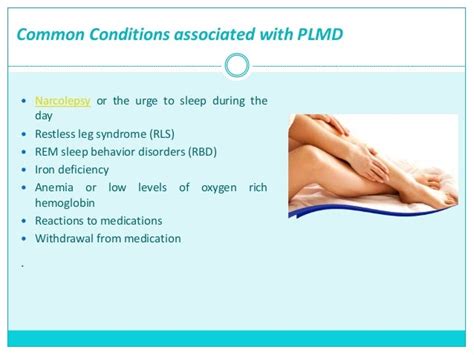
Coping with Periodic Limb Movement Disorder
Coping with periodic limb movement disorder can be challenging, but there are several strategies that can help. These include: * Keeping a sleep diary to track sleep patterns and symptoms * Establishing a regular sleep schedule * Avoiding triggers, such as caffeine and alcohol * Engaging in regular exercise and relaxation techniques * Seeking support from family and friends * Joining a support group to connect with others who have PLMDLiving with Periodic Limb Movement Disorder
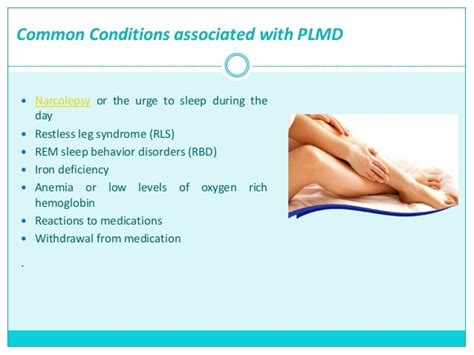
Future Directions for Periodic Limb Movement Disorder Research
Research into periodic limb movement disorder is ongoing, and future studies are likely to focus on the underlying causes of the condition, as well as the development of new treatments. Some potential areas of research include: * The role of genetics in the development of PLMD * The impact of iron deficiency on PLMD * The development of new medications and therapies for PLMD * The use of alternative therapies, such as acupuncture and massage, in managing PLMDConclusion and Final Thoughts

What is the main symptom of periodic limb movement disorder?
+The main symptom of periodic limb movement disorder is involuntary movements of the legs and arms during sleep.
How is periodic limb movement disorder diagnosed?
+Diagnosing periodic limb movement disorder typically involves a comprehensive medical history, physical examination, sleep study, and questionnaires.
What are the treatment options for periodic limb movement disorder?
+Treatment for periodic limb movement disorder typically involves a combination of lifestyle changes, behavioral therapies, and medications.
We hope this article has provided you with a comprehensive understanding of periodic limb movement disorder. If you have any questions or comments, please feel free to share them below. Additionally, if you found this article helpful, please consider sharing it with others who may be affected by PLMD. Together, we can raise awareness and promote better understanding of this complex condition.
